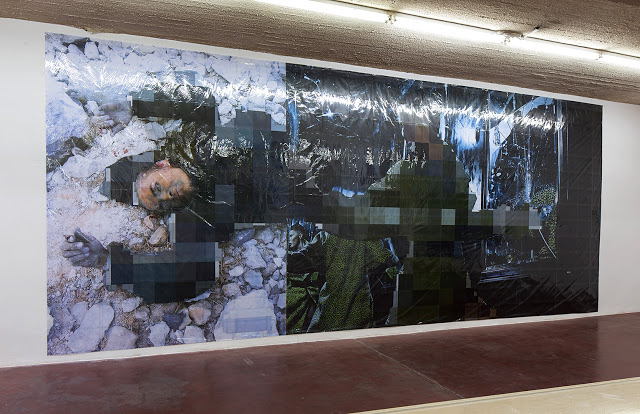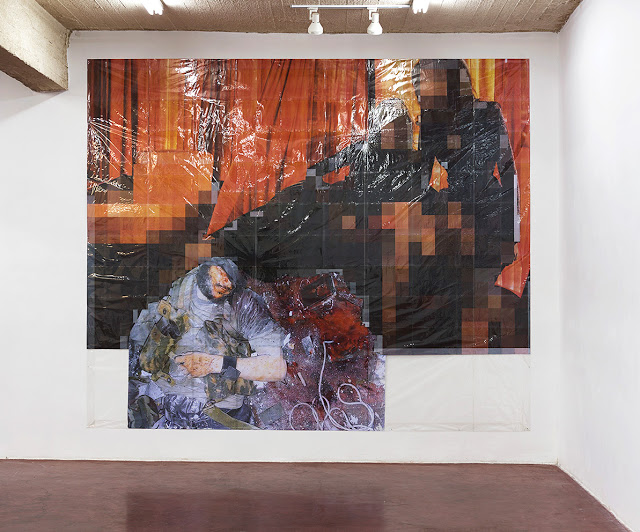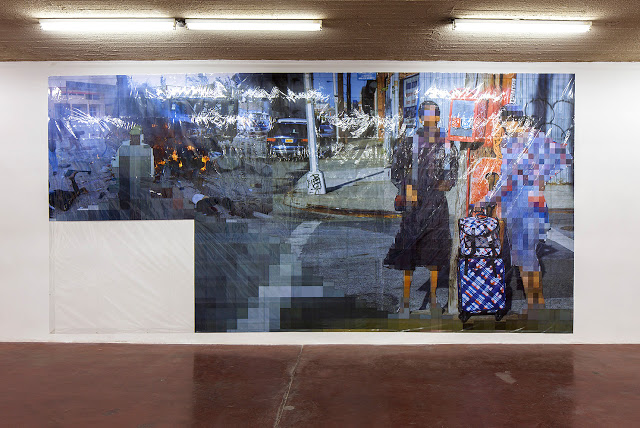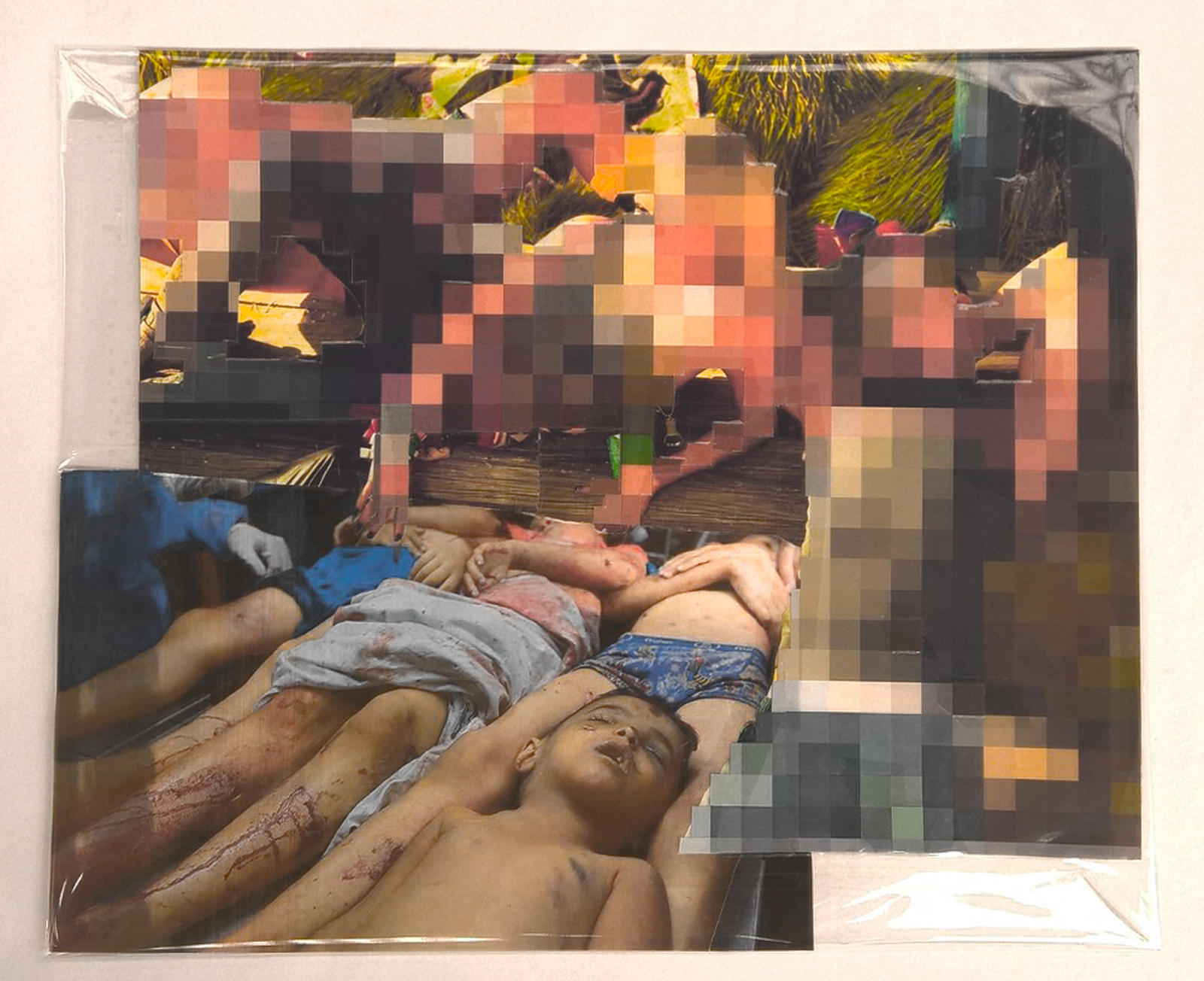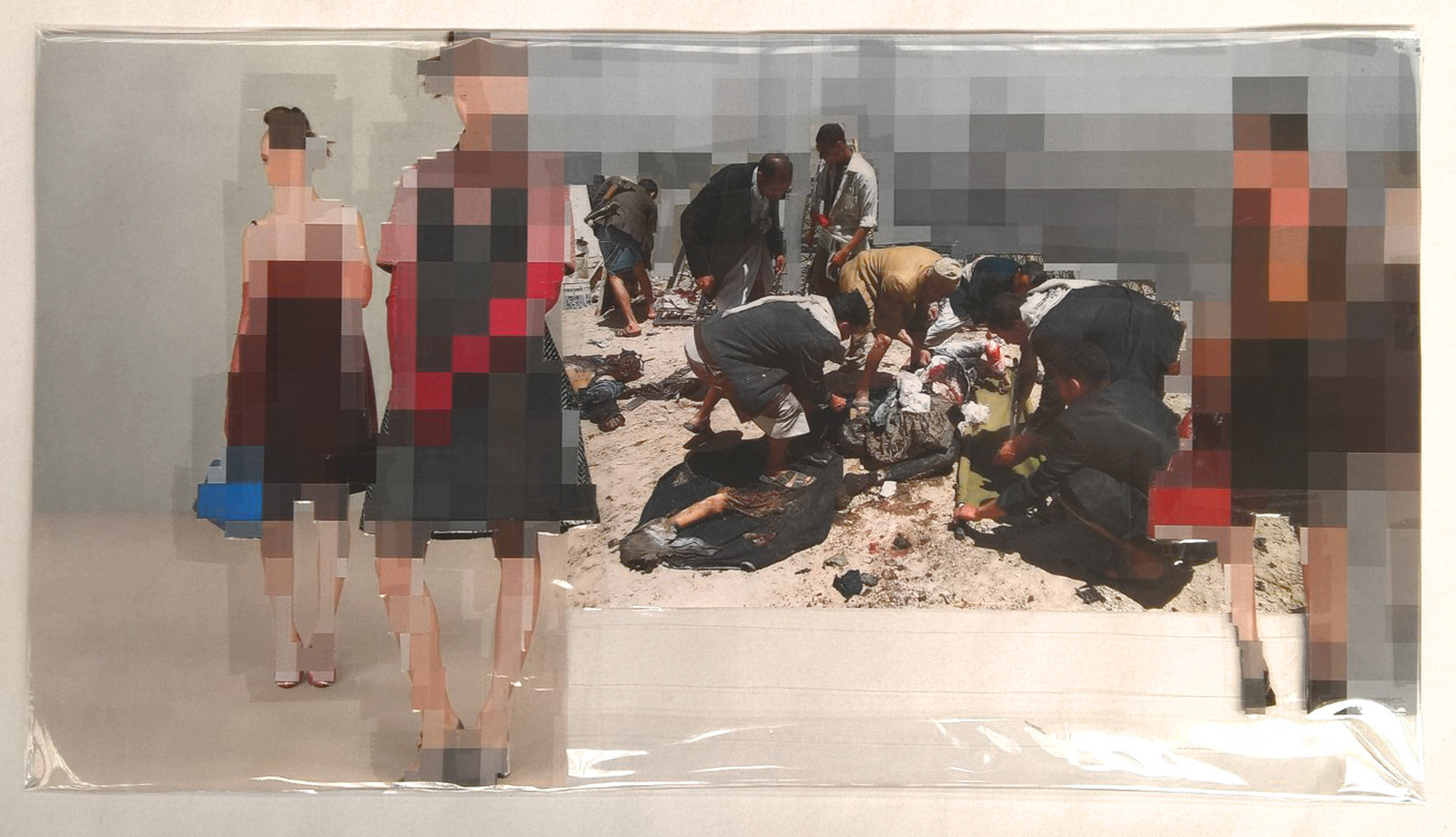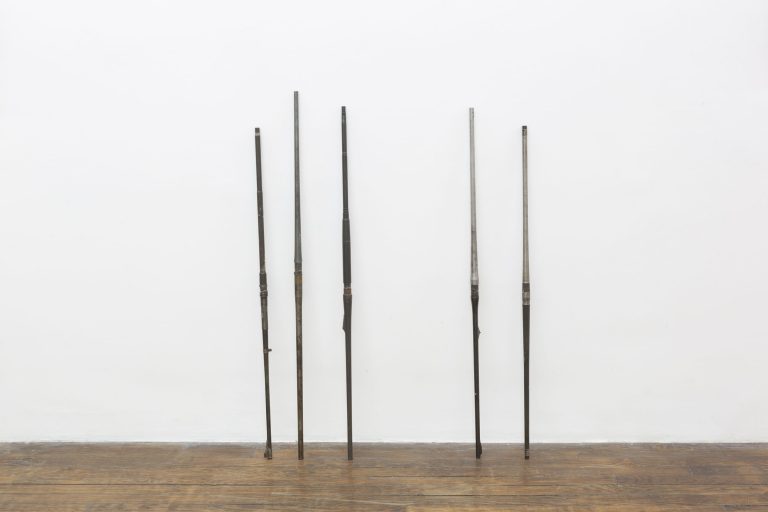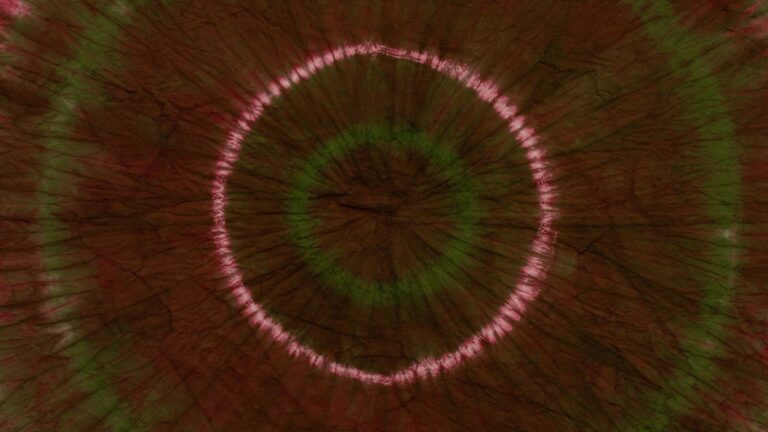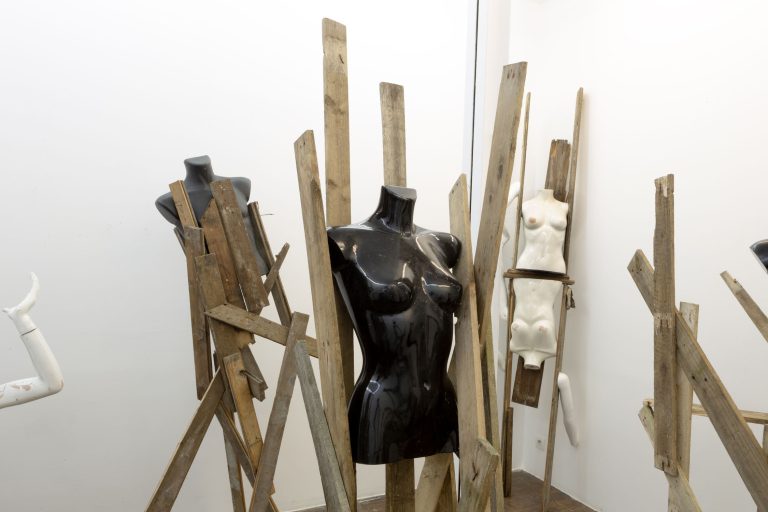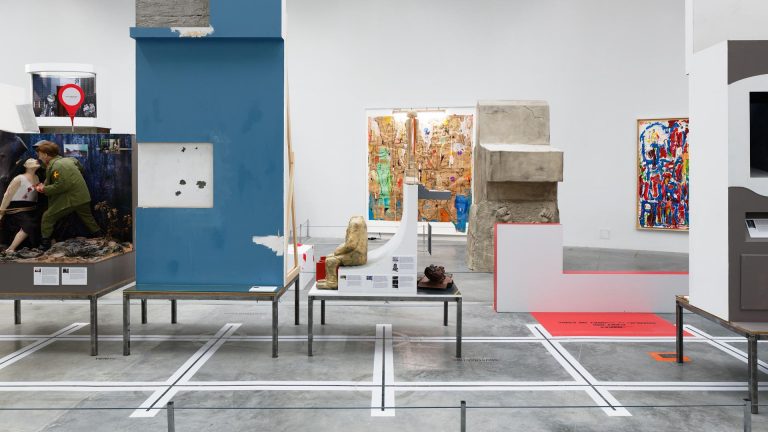Artist: Thomas Hirschhorn
Exhibition title: New Pixel-Collage
Venue: Dvir Gallery, Tel Aviv, Israel
Date: September 17 – October 22, 2016
Photography: all images copyright and courtesy of the artist and Dvir Gallery, Tel Aviv
“New Pixel-Collage” is my most recent work. I am still working and completely engaged with the problematic of pixelation. After my exhibition “Pixel-Collage” at Galerie Chantal Crousel, Paris beginning of 2016, I wanted to continue developing the thematic of pixels. The ‘new’ is my statement that “Pixel-Collage” is not a technique, not a system but a decision. Putting or removing each pixel – or even cutting it into smaller pixel parts – is a decision. It’s a political decision. In these “New Pixel-Collage” I want to reinforce the aesthetical aspect with the beauty of the pixelated part in opposition to the non-pixelated part. The new of the “New Pixel-Collage” also comes from my attempt to find, within the composition of each collage which serves as fundament, its very own logic as to what to pixelate and what to keep un-pixelated. The aim of the ‘New’ is to focus on the non-systematic logic of the “Pixel-Collage”. What is also new is the video work “Pixel-Video” which will be presented for the first time in the exhibition. Finally, with the “New Pixel-Collage” I want to insist, even heavily on what interests me strongly, passionately today and makes me work in a kind of urgency and necessity. I believe that ‘pixelation’ or blurring, masking and furthermore censorship or selfcensorship, is a growing and insidious problem, also in regard the new social medias. Obviously I don’t accept what has been pixelated in my place ‘to protect me’ and consequently don’t pixelate what is usually concealed and meant to be removed, frustrate, censor or make nonvisible.
Therefore in the new “Pixel-Collage”, I want to show pixelation or blurring in its abstract aesthetic and question: How can abstraction be understood today? How can abstraction, through pixilation, engage me in today’s world, time and reality? How can I redefine my idea of abstraction today? I want to integrate the growing phenomena of facelessness in pictures today. What interests me specifically about this aesthetic of facelessness is its formal embodiment through pixelation. This “Pixelation” phenomenon, more and more common in the media, shows us that, in order to be authentic, a picture needs to be pixelated or partly pixelated. Pixelating has taken over the role of authenticity. A pixelated picture is surely authentic if it has unacceptable areas which are concealed while the acceptable is not pixelated. It is interesting to observe that the use of pixels follows no common law at all. Partly pixelated pictures look even more authentic and are accepted as such by viewers. It therefore seems clear that pixels stand for authentication: Authentication through authority. And, in our chaotic, incommensurable, contradictory and complex world there is a huge demand for authority. Pixels deliver an aesthetic to this demand for authority, for protection and for de-responsabilization. I understand abstraction as thinking, as political thinking. Pixels in their abstraction build up a new form, opening towards a dynamic and desire of truth, truth as such, truth as something reaching beyond information, non-information or counter-information. The point is to understand how an existing published picture can become an abstraction. It seems to me that – paradoxically – the authoritarian will to use pixelation in order to hide, to ‘protect’, not show, or not make something visible has, instead, become an invitation or possibility to touch truth. Truth through pixels, through their abstraction and the aesthetic of their abstraction. To touch truth does not mean verifying information; to touch truth is an act of emancipation. The political thinking and form of the “New Pixel-Collage” is the belief in abstraction, and the belief in the aesthetic of pixilation.
“New Pixel-Collage” are collages. Making a collage means pasting together existing elements of reality to create a new world that did not exist before. A collage requires at least two different elements brought together, but can be made with more. Therefore something new, a new world, a new image, a new light is conceived. This means giving a response – through Form – to the question “How can abstraction be understood today?” Form is not just an idea Form is essential, Form is crucial, Form is the core. I want to give Form, and in giving Form I must show what I see, what I understand, what comes from myself without explanation or argumentation. Nothing is un-showable. What cannot be shown is what has no form. Everything that is ‘form’ is showable and viewable – even when incommensurable. Everything that has a form in this incommensurable world must remain incommensurable, without an attempt of becoming commensurable from not being shown or keeping our eyes shut. In order to confront the world, to struggle with its chaos, its incommensurability, in order to coexist and to cooperate in this world and with the other, I need to confront reality without distance. It is necessary to distinguish ‘sensitivity’, which to me means being ‘awake’ and ‘attentive’, from ‘hypersensitivity’, which means ‘self-enclosure’ and ‘exclusion’. Today, more than ever, I need to see everything with my own eyes in our one world, and no one can tell me what my eyes should see or not.
Thomas Hirschhorn,
Aubervilliers, Summer 2016
Thomas Hirschhorn, Pixel-Collage nº32, 2016
Prints, tape, transparent sheet, 336x396cm
Thomas Hirschhorn, Pixel-Collage nº36, 2016
Prints, tape, transparent sheet, 375x336cm
Thomas Hirschhorn, Pixel-Collage nº44, 2016
Prints, tape, transparent sheet, 360x380cm
Thomas Hirschhorn, Pixel-Collage nº43, 2016
Prints, tape, transparent sheet, 365x995cm
Thomas Hirschhorn, Pixel-Collage nº38, 2016
Prints, tape, transparent sheet, 367x850cm
Thomas Hirschhorn, Pixel-Collage nº34, 2016
Prints, tape, transparent sheet, 336x364cm
Thomas Hirschhorn, Pixel-Collage nº33, 2016
Prints, tape, transparent sheet, 370x880cm
Thomas Hirschhorn, Pixel-Collage nº30, 2016
Prints, tape, transparent sheet, 330x431cm
Thomas Hirschhorn, Pixel-Collage nº29, 2016
Prints, tape, transparent sheet, 336x405cm
Thomas Hirschhorn, Pixel-Collage nº42, 2016
Prints, tape, transparent sheet, 362x730cm
Thomas Hirschhorn, Pixel-Collage nº31, 2016
Prints, tape, transparent sheet, 339x463cm
Thomas Hirschhorn, Pixel-Collage nº47, 2016
Prints, tape, transparent sheet, 33×29 cm
Thomas Hirschhorn, Pixel-Collage nº49, 2016
Prints, tape, transparent sheet, 37,5×43,5 cm
Thomas Hirschhorn, Pixel-Collage nº51, 2016
Prints, tape, transparent sheet, 33,5×48 cm
Thomas Hirschhorn, Pixel-Collage nº52, 2016
Prints, tape, transparent sheet, 30×44,5 cm
Thomas Hirschhorn, Pixel-Collage nº54, 2016
Prints, tape, transparent sheet, 28,5×61 cm
Thomas Hirschhorn, Pixel-Collage nº55, 2016
Prints, tape, transparent sheet, 33,5×50 cm
Thomas Hirschhorn, Pixel-Collage nº56, 2016
Prints, tape, transparent sheet, 19×44 cm
Thomas Hirschhorn, Pixel-Collage nº57, 2016
Prints, tape, transparent sheet, 35×42 cm
Thomas Hirschhorn, Pixel-Collage nº58, 2016
Prints, tape, transparent sheet, 34×51 cm
Thomas Hirschhorn, Pixel-Collage nº60, 2016
Prints, tape, transparent sheet, 52×45,5 cm
Thomas Hirschhorn, Pixel-Collage nº61, 2016
Prints, tape, transparent sheet, 31×42,5 cm
Thomas Hirschhorn, Pixel-Collage nº62, 2016
Prints, tape, transparent sheet, 47×41,5 cm
Thomas Hirschhorn, Pixel-Collage nº63, 2016
Prints, tape, transparent sheet, 33×50,5 cm
Thomas Hirschhorn, Pixel-Collage nº66, 2016
Prints, tape, transparent sheet, 28×50,5 cm
Thomas Hirschhorn, Pixel-Collage nº67, 2016
Prints, tape, transparent sheet, 37×46,5 cm








